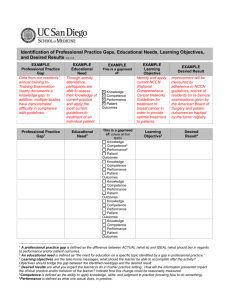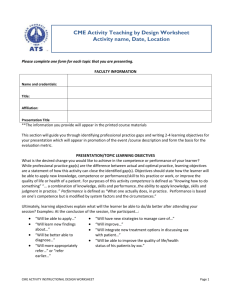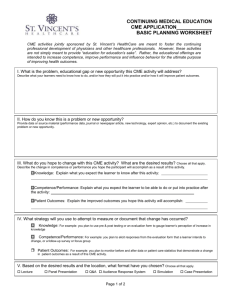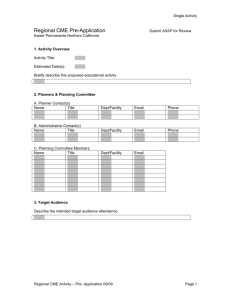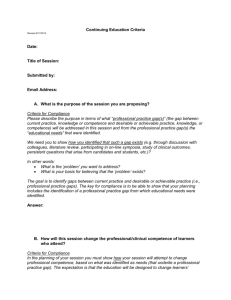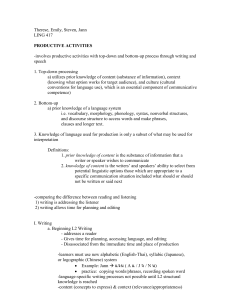A Guide for and Documentation of the Planning of a CME Activity
advertisement
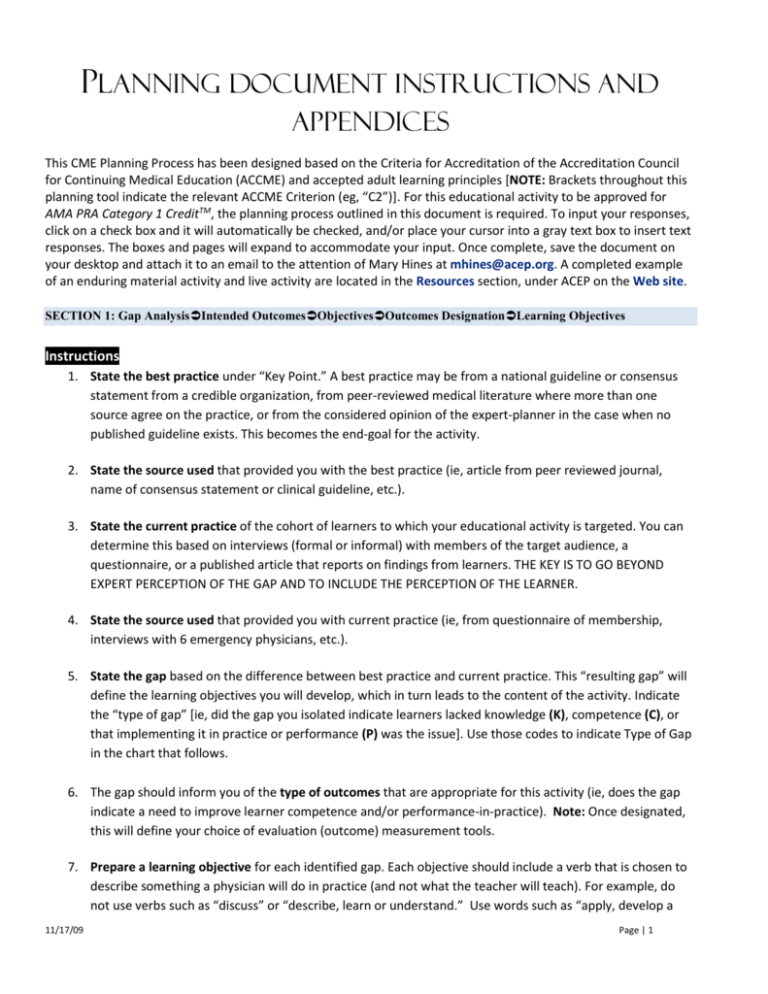
PLANNING DOCUMENT INSTRUCTIONS AND APPENDICES This CME Planning Process has been designed based on the Criteria for Accreditation of the Accreditation Council for Continuing Medical Education (ACCME) and accepted adult learning principles [NOTE: Brackets throughout this planning tool indicate the relevant ACCME Criterion (eg, “C2”)]. For this educational activity to be approved for AMA PRA Category 1 CreditTM, the planning process outlined in this document is required. To input your responses, click on a check box and it will automatically be checked, and/or place your cursor into a gray text box to insert text responses. The boxes and pages will expand to accommodate your input. Once complete, save the document on your desktop and attach it to an email to the attention of Mary Hines at mhines@acep.org. A completed example of an enduring material activity and live activity are located in the Resources section, under ACEP on the Web site. SECTION 1: Gap AnalysisIntended OutcomesObjectivesOutcomes DesignationLearning Objectives Instructions 1. State the best practice under “Key Point.” A best practice may be from a national guideline or consensus statement from a credible organization, from peer-reviewed medical literature where more than one source agree on the practice, or from the considered opinion of the expert-planner in the case when no published guideline exists. This becomes the end-goal for the activity. 2. State the source used that provided you with the best practice (ie, article from peer reviewed journal, name of consensus statement or clinical guideline, etc.). 3. State the current practice of the cohort of learners to which your educational activity is targeted. You can determine this based on interviews (formal or informal) with members of the target audience, a questionnaire, or a published article that reports on findings from learners. THE KEY IS TO GO BEYOND EXPERT PERCEPTION OF THE GAP AND TO INCLUDE THE PERCEPTION OF THE LEARNER. 4. State the source used that provided you with current practice (ie, from questionnaire of membership, interviews with 6 emergency physicians, etc.). 5. State the gap based on the difference between best practice and current practice. This “resulting gap” will define the learning objectives you will develop, which in turn leads to the content of the activity. Indicate the “type of gap” [ie, did the gap you isolated indicate learners lacked knowledge (K), competence (C), or that implementing it in practice or performance (P) was the issue]. Use those codes to indicate Type of Gap in the chart that follows. 6. The gap should inform you of the type of outcomes that are appropriate for this activity (ie, does the gap indicate a need to improve learner competence and/or performance-in-practice). Note: Once designated, this will define your choice of evaluation (outcome) measurement tools. 7. Prepare a learning objective for each identified gap. Each objective should include a verb that is chosen to describe something a physician will do in practice (and not what the teacher will teach). For example, do not use verbs such as “discuss” or “describe, learn or understand.” Use words such as “apply, develop a 11/17/09 Page | 1 strategy to…, etc.” Ensure that the objective clearly states a standard against which one can judge the success in achieving the objective. The ‘standard’ helps inform the outcomes questions you will prepare. 8. Prepare evaluation/outcomes questions depending on the “Intended Outcomes” you stated earlier. For example, if improvement in competence was indicated, then you must prepare outcomes questions related to demonstrating an improvement in competence. In addition, if improvement in performance-in-practice is indicated, you must also prepare questions relative to performance. To measure a change in competence, consider a case study with questions relating to the learner’s ability to apply knowledge with a strategy related to patient care. Present the case study and ask 3-5 related questions prior to the start of the activity to establish a base line level of competence. Use the same case study and questions postactivity to measure the change in competence. You may decide to measure competence by using paired questions. These questions ask the learners how they are currently managing their patients and based on the educational intervention, how they intend to manage them in the future. 9. Performance questions are very specific and are related to what the learner has done in his practice since completing the activity. State your questions that relate to the objectives referenced above in terms of multiple choices or yes/no format. In a multiple choice format, indicate with an asterisk which option is correct. SECTION 3: Application of Desirable Physician Attributes to CME Content [C6] INSTRUCTIONS: As the next step in refining content, planners are required to address nationally-established goals for physician core competencies as developed by the Institute of Medicine, Accreditation Council on Graduate Medical Education (ACGME), Association of American Medical Colleges (AAMC), and the American Board of Medical Specialties (ABMS) related to specialty maintenance of certification. Based on the following chart that lists all of these related national and prioritized competencies please indicate in the 4 th column specific areas of content (and the competency number identifier) in your planned CME activity that will address those national competencies. SECTION 4: Factor/Barriers Outside Provider’s Control and Strategies to Address Them [C18-19] INSTRUCTIONS: (Optional. However if you can address this area, please do.) As you continue to refine the content, planners are encouraged to give consideration to the system of care in which the learner will incorporate new or validate existing learned behaviors. Planners must be sure to (a) identify barriers that could block implementation (e.g., formulary restrictions, time not allotted for implementation of new skills, or performance behaviors, insurance doesn’t reimburse for treatments, organization doesn’t support educational efforts, lack of resources, policy issues within organization, etc.) and (b) apply strategies to address, discuss strategies to overcome or remove those barriers (if possible) in the content of the CME activity. Please indicate below the barrier(s) you have identified and the strategies you will employ in this activity to address or remove them: SECTION 5: Format and Design Related to Sustaining Results INSTRUCTIONS: The purpose of CME is change in behavior or validation that changes already made are consistent with best practices. Format decisions include (a) venue appropriate to your target audience and to achieve best practices (desired results), (b) methods used to engage learners in the educational process—especially those that serve to demonstrate application of knowledge to performance, and (3) ancillary processes and tools that sustain learning goals. NOTE: Refer to Appendix C for guidance on format choices. In the table below, indicate your choices for each element above and the rationale for that choice SECTION 6: Faculty Selection Faculty that are selected should have a demonstrated expertise in the therapeutic field, strong presentation and communication skills, and ability to address the gaps and learning objectives expressed in this planning document. It is advisable to select faculty with the most expertise and teaching skills and the least amount of conflicts of interest [C7]. List the faculty and their qualifications: 11/17/09 Page | 2 Section 7: Collaborations to Enhance Results [C20] INSTRUCTIONS: Whenever possible, you should identify other stakeholders applicable to this topic and cohort of learners and if collaboration with one or more of those could make a positive impact on your intended results. NOTE: Collaborators are purposefully chosen and not necessarily a joint sponsor or educational partner with whom you have contracted to assist in managing the activity. A collaborator is an organization with special expertise in the subject matter or influence over the Section 8: Institutional or System Framework for Quality [C21] INSTRUCTIONS: A CME provider should always be focused on integrating and contributing to healthcare quality improvement so that the CME program becomes integral to institutional or system QI efforts. Indicate below the ‘quality connections’ you have made for this activity and the contribution the activity will make to quality improvement or patient safety at your institution or to the framework for quality to which you are connected for this discipline of medicine. PLEASE CONSULT THE APPENDICES THAT FOLLOW FOR GUIDANCE IN VARIOUS ASPECTS OF PLANNING CME. 11/17/09 Page | 3 APPENDIX A GLOSSARY OF TERMS 11/17/09 Barrier: Personal or system block to implementation of new knowledge Best practices: The highest standard applied Desired results: Best practices and what learners will apply based on knowledge gained from the educational activity Gap: Real or perceived need for improvement in practice, knowledge, and/or patient outcomes; a gap is the difference between a best practice and a current practice. Intervention: The content of the learning activity and the educational/instructional methods by which content is addressed Competence: Ability to apply the knowledge to a practice-based situation Outcomes: The ability of the learner to apply (1) knowledge, (2) adopt new strategies to apply knowledge to practice, (3) real or anecdotal impact on patient outcomes Performance: Skills, ability and strategies that one has implemented in practice Page | 4 APPENDIX B Verbs for Writing Learning Objectives 11/17/09 Page | 5 APPENDIX C 11/17/09 Page | 6 APPENDIX D1 1 Developed by Judy M. Sweetnam, M.Ed., CCMEP, Steve Passin & Associates, LLC 11/17/09 Page | 7 APPENDIX E EDUCATIONAL OUTCOMES WORKSHEET2 INSTRUCTIONS: Evaluations are tools used to determine if the result you intended for learners will be achieved. The choice of which evaluation tools to use depends on (1) the designation indicated earlier in this planning document (i.e., improved competence, performance, or patient outcomes), (2) the method/type of activity and applicability of the tool (i.e., live activity, Internet, print), and (3) available resources. Planners are encouraged to use pre- and post-evaluations whenever possible to measure improvement in competence. IF YOU DESIGNATED THIS ACTIVITY FOR IMPROVEMENT IN COMPETENCE, COMPLETE THIS SECTION: Option 1 to measure competence (case study model) Option 1 – Step 1 WRITE A BRIEF CASE STUDY BELOW THAT IS REFLECTIVE OF THE STRATEGIES YOUR LEARNERS ARE EXPECTED TO APPLY TO PRACTICE. THIS CASE STUDY WILL BE UTILIZED PRIOR TO THE START OF THE ACTIVITY AND THEN AGAIN AT THE COMPLETION OF THE ACTIVITY (NOTE: see Appendix D for a sample case study) INSTRUCTIONS: Prepare questions to accompany the above case study. Questions should demonstrate an application of knowledge to a strategy related to the clinical practice scenario above: Correct Answer? Option 1 – Step 2 Question Stated in Terms of Clinical Strategy <<<<<<<<<<<<<<<<<<<<<<<<<<< OR >>>>>>>>>>>>>>>>>>>>>>>>>>>>> Option 2 to measure competence (paired question model) PRE-ACTIVITY QUESTION: How often do you currently use each the following patient care strategies? (1=never to 5=always) Strategy 1: 1 2 3 4 5 1 2 3 4 5 1 2 3 4 5 Option 2 – Pretest Strategy 2: Strategy 3: Strategy 4: 2 This worksheet was developed in collaboration with Derek Dietze, president of Improve CME. 11/17/09 Page | 8 1 2 3 4 5 QUESTION TO ASK AT END OF ACTIVITY: Based on your participation in this CME activity, how often do you now plan to use each the following patient care strategies? (1=never to 5=always): Strategy 1: 1 2 3 4 5 1 2 3 4 5 1 2 3 4 5 2 3 4 5 Option 2 - Posttest Strategy 2: Strategy 3: Strategy 4: 1 <Insert or delete rows as needed> IF YOU DESIGNATED THIS ACTIVITY FOR IMPROVEMENT IN PERFORMANCE, COMPLETE THIS SECTION: NOTE: These questions will be posed to learners 3 months post-activity. Base these questions on the “identified” best practices as indicated earlier in this planning document. They are performance changes you intended as a result of this Question 1: Question 2: Question 3: Question 4: Question 5: educational activity. IF YOU DESIGNATED THIS ACTIVITY FOR IMPROVEMENT IN PATIENT OUTCOMES, COMPLETE THIS SECTION: NOTE: These questions will be appended to the follow-up questionnaire that measures performance-in-practice (above). These questions will be answered by the learner based on his or her anecdotal and observational experiences related to changes in patient outcomes as a result of participation in this activity. Question: Please describe 2 patient outcomes you’ve observed based on any of the following interventions you’ve implemented from this CME activity: Interventions You’ve Implemented <insert new behavior or patient intervention anticipated> <insert new behavior or patient intervention anticipated> 11/17/09 Patient Observations You’ve Made Observation 1: Observation 2: Observation 1: Page | 9 Observation 2: 11/17/09 Page | 10
